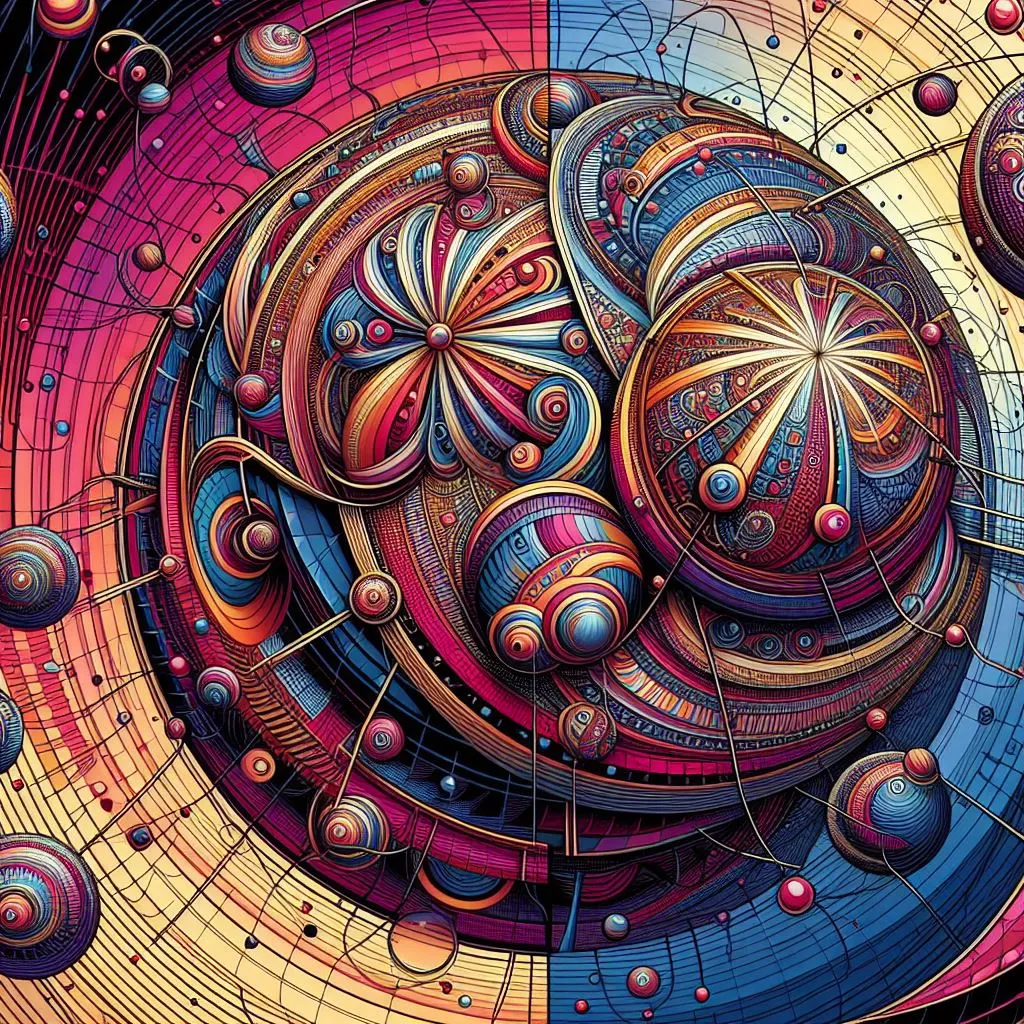Navigating Non-Euclidean Worlds: Hyperbolic and Spherical Geometry

Geometry, a branch of mathematics dedicated to unraveling the properties and relationships of shapes, has historically been under the sway of Euclidean principles. Despite its historical dominance, the mathematical landscape extends far beyond the boundaries set by Euclid's classical geometry. In this intellectual journey, we embark on an exploration that delves into the captivating realms of non-Euclidean geometry, with a particular focus on hyperbolic and spherical geometry. By deviating from the well-trodden Euclidean path, we uncover unique landscapes and dimensions, pushing the boundaries of our geometric understanding. The 19th-century revelations by mathematicians such as Nikolai Lobachevsky and János Bolyai paved the way for the emergence of hyperbolic geometry, where the familiar parallel postulate was reimagined, leading to the creation of hyperbolic surfaces characterized by constant negative curvature. To make these non-Euclidean spaces more accessible, mathematicians introduced models like the Poincaré disk, providing a visual representation of the hyperbolic plane. On the opposite end of the curvature spectrum, spherical geometry explores spaces with positive curvature, challenging our intuition with properties such as the sum of angles in a triangle exceeding 180 degrees. Practical applications of spherical geometry extend into navigation, astronomy, and geography, influencing tools like the sextant and aiding in map projections. I'm here to provide guidance and support to help you navigate through the captivating realms of Euclidean and non-Euclidean Geometry assignment.

Beyond the realm of practicality, the unique properties of hyperbolic and spherical geometry have left an indelible mark on art and design. M.C. Escher's intricate hyperbolic tessellations and architectural marvels like Buckminster Fuller's geodesic domes showcase the aesthetic appeal and creative potential inherent in these mathematical concepts. As we traverse these non-Euclidean worlds, we encounter the unifying framework of projective geometry, bridging the gap between Euclidean and non-Euclidean realms by studying geometric properties invariant under perspective transformations. In conclusion, our journey through non-Euclidean geometry illuminates the richness and diversity of the mathematical world, transcending the confines of Euclid's classical principles. From hyperbolic surfaces to spherical landscapes, these deviations from the familiar Euclidean path inspire a deeper understanding of space, influencing disciplines ranging from mathematics and navigation to art and design.
The Foundations of Euclidean Geometry:
The foundations of Euclidean geometry, established by the ancient Greek mathematician Euclid around 300 BCE, provide the bedrock upon which classical geometry stands. Euclidean geometry is characterized by a set of postulates and axioms that define the fundamental principles governing the relationships and properties of shapes in a flat, two-dimensional space. These principles encompass familiar concepts such as parallel lines, the Pythagorean theorem, and the sum of angles in a triangle. Euclid's work, encapsulated in his seminal work "Elements," has served as the cornerstone of mathematical thought for centuries. The parallel postulate, in particular, asserts that given a line and a point not on it, there is exactly one parallel line through the external point. This seemingly simple postulate has profound implications and distinguishes Euclidean geometry from its non-Euclidean counterparts. As we embark on a journey to explore hyperbolic and spherical geometries, it becomes essential to grasp the classical principles of Euclidean geometry, as they form the basis for our understanding of space and shape in the more intricate and varied worlds that lie beyond the constraints of Euclid's postulates.
Breaking the Euclidean Mold: Hyperbolic Geometry:
Breaking the Euclidean mold, hyperbolic geometry emerged as a revolutionary departure from classical mathematical principles during the 19th century. Pioneered by Nikolai Lobachevsky and János Bolyai, this non-Euclidean geometry challenged the centuries-old postulates of Euclid, particularly the parallel postulate. In hyperbolic geometry, the parallel postulate is replaced with the notion that given a line and a point not on it, there are infinitely many lines parallel to the original line through the external point. This seemingly subtle alteration opens up a vast and intriguing world of possibilities, where space exhibits constant negative curvature, defying the familiar intuitions of Euclidean geometry. Hyperbolic surfaces, the hallmark of this geometry, captivate mathematicians and enthusiasts alike with their intricate patterns and paradoxical properties. To render these abstract concepts more accessible, mathematicians devised models such as the Poincaré disk model, which maps the hyperbolic plane onto a unit disk. The exploration of hyperbolic geometry not only reshaped the foundations of mathematics but also found applications in fields ranging from art to physics, leaving an indelible mark on the landscape of mathematical thought and opening doors to further exploration of non-Euclidean realms.
A. Hyperbolic Surfaces:
In hyperbolic geometry, the parallel postulate is replaced with the idea that given a line and a point not on it, there are infinitely many lines parallel to the original line through the external point. This seemingly simple modification opens up a world of possibilities, leading to the creation of hyperbolic surfaces. These surfaces exhibit constant negative curvature and challenge our intuitions about space.
B. The Poincaré Disk Model:
To make hyperbolic geometry more tangible, mathematicians developed models to represent these non-Euclidean spaces. One such model is the Poincaré disk model, which maps the hyperbolic plane onto a unit disk. Understanding this model is crucial for visualizing hyperbolic geometry and its unique properties.
Curvature in Spherical Geometry:
In the captivating realm of spherical geometry, the curvature of surfaces takes center stage, offering a departure from the familiar principles of Euclidean space. Unlike the flat, planar surfaces of Euclid's geometry, spherical geometry explores spaces with positive curvature, akin to the surface of a sphere. At its core, the sum of angles in a spherical triangle exceeds 180 degrees, challenging our conventional understanding of geometric relationships. Delving into the properties of spherical triangles unveils a world where parallel lines converge, presenting a stark contrast to the parallel lines of Euclidean space. This unique curvature is not merely a mathematical abstraction; it finds practical applications in various fields. Navigation tools, such as the sextant, leverage the principles of spherical geometry to navigate the Earth's curved surface accurately. Moreover, in the realm of cartography, understanding the curvature of the Earth is essential for creating accurate map projections that faithfully represent our planet. Spherical geometry extends its influence beyond the theoretical, shaping the foundations of navigation, astronomy, and geography. The study of this non-Euclidean geometry not only broadens our mathematical perspectives but also highlights its integral role in practical, real-world applications that impact our understanding of space and the intricate relationships within it.
A. Properties of Spherical Triangles:
In spherical geometry, the sum of angles in a triangle exceeds 180 degrees, challenging the familiar Euclidean notion. We explore the properties of spherical triangles and how they differ from their planar counterparts. Additionally, we discuss how lines on a sphere behave differently from those in Euclidean space.
B. Applications of Spherical Geometry:
Spherical geometry finds practical applications in navigation, astronomy, and geography. Navigational tools such as the sextant rely on the principles of spherical geometry to determine distances and angles on the Earth's surface. Understanding the curvature of the Earth is essential for accurate map projections and celestial navigation.
Hyperbolic and Spherical Geometry in Art and Design:
Hyperbolic and spherical geometry transcend the confines of mathematics, making a profound impact on the realms of art and design. In the world of hyperbolic geometry, artists draw inspiration from the mesmerizing tessellations famously championed by M.C. Escher. These intricate patterns, repeating infinitely within hyperbolic space, create captivating visual illusions that challenge conventional perceptions of dimension and symmetry. Escher's artistic exploration not only showcases the aesthetic allure of hyperbolic geometry but also serves as a testament to the symbiotic relationship between mathematics and artistic expression. On the other hand, spherical geometry finds its place in architectural marvels and design aesthetics. Architects, influenced by the positive curvature of a sphere, have given rise to iconic structures such as Buckminster Fuller's geodesic domes. These geometrically intricate domes not only captivate the eye but also demonstrate the structural strength and efficiency derived from spherical principles. The marriage of mathematics and design goes beyond physical structures, permeating contemporary design philosophies that seek inspiration from non-Euclidean geometries. Whether manifested in the delicate complexity of hyperbolic tessellations or the structurally sound elegance of spherical designs, the integration of these mathematical concepts into art and design enriches our visual experiences, pushing the boundaries of creativity and challenging traditional notions of form and space. As artists and designers continue to navigate these non-Euclidean worlds, they not only redefine aesthetic paradigms but also contribute to a broader cultural appreciation of the intricate beauty inherent in mathematical abstraction.
A. Escher's Hyperbolic Tessellations:
The famous artist M.C. Escher created mesmerizing artworks that delve into the world of hyperbolic geometry. We explore Escher's use of hyperbolic tessellations, where shapes repeat indefinitely, creating captivating and visually stunning patterns.
B. Architectural Marvels and Spherical Designs:
Architects have drawn inspiration from spherical geometry to create iconic structures that challenge traditional design principles. From the geodesic domes of Buckminster Fuller to contemporary architectural feats, we examine how spherical geometry influences modern design.
The Unified Framework: Projective Geometry:
In the unifying embrace of projective geometry, the disparate realms of hyperbolic and spherical geometries find a common ground, transcending the boundaries that traditionally separate mathematical landscapes. Projective geometry, with its roots in the Renaissance and a culmination in the 19th century, serves as a bridge between Euclidean principles and the non-Euclidean wonders we've encountered. It introduces the concept of perspective in a geometric sense, allowing mathematicians to study properties that remain constant under projective transformations. This framework offers a cohesive understanding of geometric concepts that extends beyond the constraints of specific geometries. In the realm of hyperbolic geometry, projective geometry helps elucidate the relationships between points at infinity and enables a more profound exploration of geometric transformations. Similarly, in the spherical domain, projective geometry provides a lens through which the curvature of the sphere can be understood in a broader context. The beauty of projective geometry lies in its ability to encompass diverse geometric spaces, fostering a unified language that allows mathematicians to draw connections between seemingly disparate worlds. As we navigate this unified framework, we gain a deeper appreciation for the interconnectedness of mathematical concepts and the power of abstraction to reveal the underlying harmony in the intricate tapestry of geometry.
Conclusion:
In conclusion, the journey through the non-Euclidean worlds of hyperbolic and spherical geometry has been a captivating exploration of mathematical landscapes beyond the confines of classical Euclidean principles. The deviations from Euclid's postulates led us to hyperbolic surfaces, where parallel lines can diverge infinitely, challenging our intuitions about space and curvature. The Poincaré disk model became a crucial tool for visualizing these intricate geometries, making the seemingly abstract concepts more accessible. On the opposite end of the curvature spectrum, spherical geometry introduced us to the positive curvature of surfaces, manifesting on the Earth's sphere and influencing practical applications in navigation and astronomy. The deviation from the familiar Euclidean triangle properties in spherical space opened up new perspectives on geometry's fundamental concepts. Moreover, the artistic and architectural implications of hyperbolic and spherical geometry have demonstrated how mathematical principles can inspire creativity and innovation. From Escher's mesmerizing hyperbolic tessellations to the structural elegance of spherical designs in architecture, these non-Euclidean geometries continue to leave an indelible mark on human expression. The unified framework of projective geometry emerged as a bridge between Euclidean and non-Euclidean realms, showcasing the interconnectedness of mathematical ideas. As we conclude this journey, we recognize that the exploration of these non-Euclidean worlds not only deepens our understanding of mathematics but also enriches our appreciation for the boundless creativity and beauty inherent in the language of shapes and spaces.